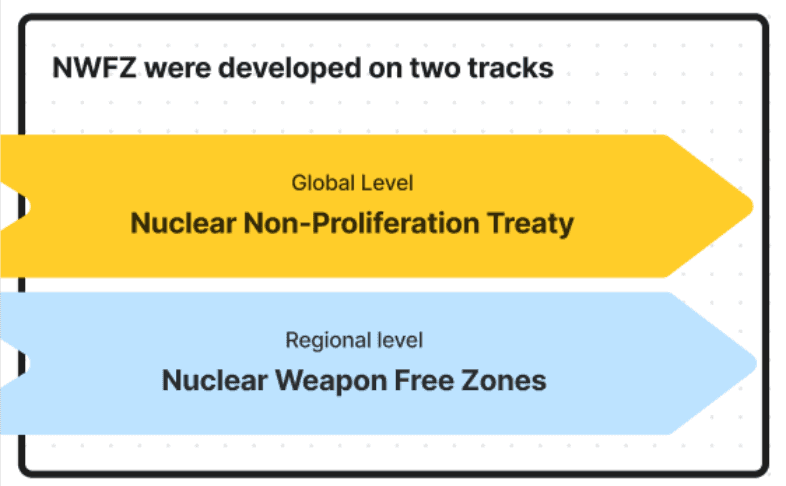Introduction
As indicated above the establishment of Nuclear-Weapon-Free Zones is a regional approach to strengthen the global nuclear non-proliferation regime. It supports international efforts towards peace and security by the denuclearization of certain areas and by the consolidation of disarmament norms. Interestingly enough, the first Nuclear-Weapon-Free Zones were established for uninhabited areas, such as the Antarctica in 1959, the outer space in 1967, the seabed in 1971, as well as the Moon and other celestial bodies in 1979. More detailed information can be found behind the tiles if you are interested.
Antarctic Treaty
- Opened for signature: 1959
- Entry into force: 1961
- Article I: 1. Antarctica shall be used for peaceful purposes only. There shall be prohibited, inter alia, any measures of a military nature, such as the establishment of military bases and fortifications, the carrying out of military maneuvers, as well as the testing of any type of weapons.
- Article V: 1. Any nuclear explosions in Antarctica and the disposal there of radioactive waste material shall be prohibited.
Treaty on Principles Governing the Activities of States in the Exploration and Use of Outer Space, including the Moon and Other Celestial Bodies
- Opened for signature and entry into force: 1967
- Article IV: States Parties to the Treaty undertake not to place in orbit around the earth any objects carrying nuclear weapons or any other kinds of weapons of mass destruction, install such weapons on celestial bodies, or station such weapons in outer space in any other manner.
Agreement Governing the Activities of States on the Moon and Other Celestial Bodies
- Opened for signature: 1979
- Entry into force: 1984
- Article III: 3. States Parties shall not place in orbit around or other trajectory to or around the moon objects carrying nuclear weapons or any other kind of weapons of mass destruction or place or use such weapons on or in the moon.
Treaty on the Prohibition of the Emplacement of Nuclear Weapons and Other Weapons of Mass Destruction on the Sea-Bed and the Ocean Floor and in the Subsoil Thereof
- Opened for signature: 1971
- Entry into force: 1972
- Article I: 1. The States Parties to this Treaty undertake not to emplant or emplace on the sea-bed and the ocean floor and in the subsoil thereof beyond the outer limit of a sea-bed zone, as defined in article II, any nuclear weapons or any other types of weapons of mass destruction as well as structures, launching installations or any other facilities specifically designed for storing, testing or using such weapons.
It seems that it was relatively easy to reach agreement that certain “public” areas and spaces should not be considered for the deployment of nuclear weapons. For populated areas, the discussions proved to be much more difficult.
In addition to the NWFZs described above, there are additional “special cases”, where individual countries, or parts of a country, unilaterally declared themselves as a nuclear weapon-free zone. They are not normally shown in the lists of global NWFZs. However, they should at least be mentioned here for the sake of completeness: Austria, the former GDR, the Philippines, New Zealand and Mongolia. More detailed information can be found behind the tiles if you are interested.
NWFZ Special Cases
Austria
- Declaration: 1999
- Federal Constitutional Act for a Nonnuclear Austria: § 1. Nuclear weapons must not be manufactured, stored, transported, tested or used in Austria. Facilities for stationing nuclear weapons must not be set up.
Former German Democratic Republic
- Declaration: 1990
- Treaty on the Final Settlement with Respect to Germany: Article V: 3. Following the completion of the withdrawal of the Soviet armed forces from the territory of the present German Democratic Republic and of Berlin, units of German armed forces assigned to military alliance structures in the same way as those in the rest of German territory may also be stationed in that part of Germany, but without nuclear weapon carriers. […] Foreign armed forces and nuclear weapons or their carriers will not be stationed in that part of Germany or deployed there.
The Philippines
- Declaration: 1987
- The 1987 Constitution of the Republic of the Philippines: Section 8. The Philippines, consistent with the national interest, adopts and pursues a policy of freedom from nuclear weapons in its territory.
New Zealand
- Declaration: 1987
- New Zealand Nuclear Free Zone, Disarmament, and Arms Control Act 1987: An Act to establish in New Zealand a Nuclear Free Zone, to promote and encourage an active and effective contribution by New Zealand to the essential process of disarmament and international arms control.
Mongolia
- Declaration: 1992
- Law of Mongolia on its nuclear-weapon-free status: The purpose of the present Law is to regulate relations pertaining to the preservation of the territory of Mongolia in its entirety, including its air space, land, waters and the sub-soil free from nuclear weapons, which constitutes an important factor for ensuring Mongolia’s security.
